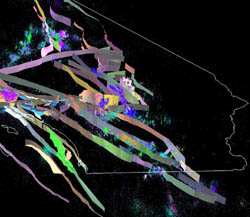Big Impacts of Small Tremors
Puny tremors may be the real movers and shakers of the seismic world. A geophysicist publishing in the 1 August PRL suggests that small earthquakes collectively trigger more aftershocks than do less frequent, larger temblors, according to earthquake records. She also proposes a new connection between the arrangement of earthquakes around a fault and the number of aftershocks. The findings could change how geoscientists model fault system stresses and estimate earthquake risk.
A fracture zone in the earth’s crust is like a buttoned shirt stretched a little too tight. When one button pops off, the stress moves to the neighboring buttons. Similarly, when an earthquake occurs, the stress gets redistributed around the fault. Geophysicists create complex maps of fault zones, plotting areas of high and low stress in the earth’s crust and revising them after each quake, always looking for hints of future earthquakes. For simplicity, these stress field maps often account only for large earthquakes, but some researchers have suggested that smaller quakes are important, too. In her paper, Agnes Helmstetter, now of the University of California, Los Angeles, uses the most complete analysis to date to argue that maps that ignore small quakes miss a big part of the picture.
Helmstetter studied aftershocks in Southern California earthquake records from the past 28 years. Bigger quakes produce more aftershocks than smaller ones, but smaller quakes are more common. So common, she found, that they generate more total seismic activity in a given year than do larger earthquakes. Her conclusion came from calculating the parameter called alpha, which characterizes the relationship between the magnitude of an earthquake and the number of aftershocks it produces.
An earthquake happens when two pieces of the earth’s crust rub against one another along a fault plane that slices down through the ground. The magnitude depends on the active area of that slice. Helmstetter defined an aftershock as any quake that occurred within a specific time and distance of any other earthquake, so aftershocks themselves could trigger other quakes. Many geophysicists have assumed alpha to be one, meaning the two quantities are proportional–double the fault plane area and you double the number of aftershocks. Instead, Helmstetter found alpha to be 0.8, which would imply relatively fewer aftershocks for larger quakes.
Helmstetter also proposes that alpha gives information on the spatial patterns of earthquakes. Plotting the locations of a large number of earthquake and aftershock centers in three dimensions, geophysicists characterize the pattern with a number called the fractal dimension. A lower fractal dimension corresponds to a sparser network on this map. According to Helmstetter’s analysis, if alpha is 0.8 rather than 1.0, then the fractal dimension is 1.6, rather than 2.0. This lower fractal dimension would mean that aftershock centers aren’t uniformly spread over the plane of the original quake’s fault, but rather along a sparser network of lines radiating from it. A study in Japan found a fractal dimension larger than two, so Helmstetter believes this property depends on a region’s specific geology.
Helmstetter’s finding of the significant effects of small earthquakes is “a very important result that is not yet widely realized in the geophysics [and] physics communities,” says Karen Felzer of Harvard University. John Vidale of the University of California at Los Angeles says that Helmstetter and other researchers are “building an ever more convincing case that most earthquakes have been triggered by previous earthquakes, and small earthquakes are an important link in that process.”
–Kim Krieger
Kim Krieger is a freelance science writer in Norwalk, Connecticut.





